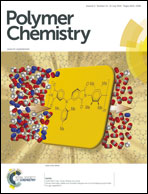Polystyrene with hydrophobic end groups: synthesis, kinetics, interfacial activity, and self-assemblies templated by breath figures†
Abstract
The breath figure method has emerged as a new self-assembly technique to fabricate ordered porous materials, which show potential applications in many fields, such as size-selective separation membranes. However, it is challenging to customize the structures, especially to precisely tune the pore size in a wide range. Moreover, the relationship between polymer structure and film morphologies is still unknown. In this paper, we report a facile, effective, and controllable way to manipulate the evolution of morphologies of honeycomb films, which is based on the blends of an amphiphilic block copolymer and polystyrenes with hydrophobic end groups. A series of atom transfer radical polymerization (ATRP) initiators with alkyl or fluorinated groups were synthesized for polystyrenes with hydrophobic end groups. Polymerization kinetics confirmed the viability of these ATRP initiators. Surface segregation behaviors of the hydrophobic end groups were demonstrated by measuring the surface chemical composition and surface free energies. We found that the polystyrenes with hydrophobic end groups form ordered films only at high polymer concentration (40–60 mg mL−1); moreover, the use of blends of two types of polystyrenes, one of which has a hydrophobic end group whereas the other has a hydrophilic block, can greatly increase the regularity of the honeycomb films and provide the possibility to fine-tune the pore diameter. Moreover, the evolution of surface morphologies of the films can be ideally correlated with the surface free energies of the end-functionalized polymers.


 Please wait while we load your content...
Please wait while we load your content...